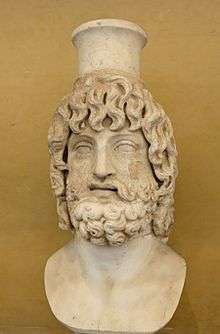Modius (headdress)
The modius is a type of flat-topped cylindrical headdress or crown found in ancient Egyptian art and art of the Greco-Roman world. The name was given by modern scholars based on its resemblance to the jar used as a Roman unit of dry measure,[1][2] but it probably does represent a grain-measure, and symbolized powers over fecundity in those wearing it.

The modius is worn by certain deities, including Mut,[3] Eleusinian deities and their Roman counterparts, the Ephesian Artemis and certain other forms of the goddess,[4] Hecate, and Serapis.[5] On some deities it represents fruitfulness.[6]
It is thought to be a form mostly restricted to supernatural beings in art, and rarely worn in real life, with two probable exceptions. A tall modius is part of the complex headdress used for portraits of Egyptian queens, ornamented variously with symbols, vegetative motifs, and the uraeus.[7] It was also the distinctive headdress of Palmyrene priests.[8][9]
See also
References
- Judith Lynn Sebesta and Larissa Bonfante, The World of Roman Costume (University of Wisconsin Press, 2001), p. 245
- Irene Bald Romano, Classical Sculpture: Catalogue of the Cypriot, Greek, And Roman Stone Sculpture in the University Of Pennsylvania Museum of Archaeology and Anthropology (University of Pennsylvania Museum of Archaeology, 2006), p. 294.
- Betsy M. Bryan, "A Newly Discovered Statue of a Queen from the Reign of Amenhotep III," in Servant of Mut: Studies in Honor of Richard A. Fazzini (Brill, 2007), p. 32.
- Joseph Eddy Fontenrose, Didyma: Apollo's Oracle, Cult, and Companions pp. 131–132.
- Brunilde Sismondo Ridgway, Hellenistic Sculpture: The Styles of ca. 331–200 B.C. (University of Wisconsin Press, 2001), p. 95.
- Fontenrose, Didyma, p. 131.
- Bryan, "A Newly Discovered Statue of a Queen," p 36ff.; Paul Edmund Stanwick, Portraits of the Ptolemies: Greek Kings As Egyptian Pharaohs (University of Texas Press, 2002), p. 35 et passim.
- Romano, Classical Sculpture, p. 294
- Lucinda Dirven, The Palmyrenes of Dura-Europos: A Study of Religious Interaction in Roman Syria (Brill, 1999), pp. 246–247.
